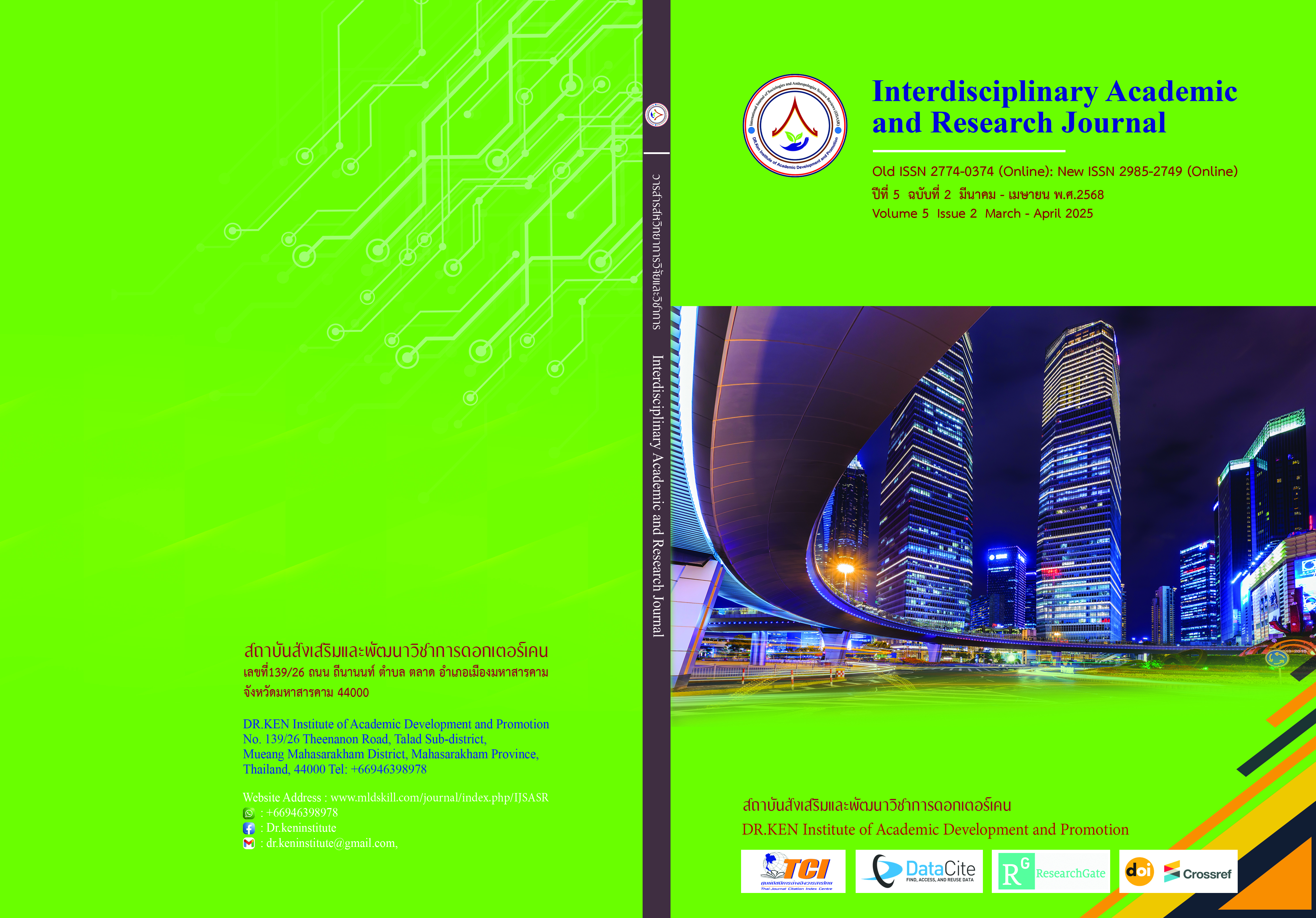Organizing Activities for Reading Nursery Rhymes with Pictures to Promote The Speaking Abilities of Young Children
DOI:
https://doi.org/10.60027/iarj.2025.278127Keywords:
Reading Nursery Rhymes with Pictures Activities, Ability to Speak, Young ChildrenAbstract
Background and Aims: The activity of reading rhyming words with pictures is an activity in which teachers stimulate by using pictures to accompany the reading of rhyming words. The nature of the rhyming words is fun content and stories close to children. When the rhyming words are finished reading, teachers let the children express their thoughts by talking about the stories in the rhyming words, which is an important foundation for developing speaking skills for early childhood children. Thus, the purpose of this research wasto compare the speaking abilities of young children before and after organizing rhyming reading activities.
Methodology: The target group used in this research isan early childhood child aged 5 -6 years who is studying in Kindergarten, Year 3, Semester1, Academic Year 2023, Kantharawichai Kindergarten School. Maha Sarakham Province Under the jurisdiction of the Maha Sarakham Primary Educational Service Area Office, Area 1, a total of 25 people were obtained from a purposive selection. The tools used inthis research include an activities plan for Reading Nursery Rhymes With Pictures and measuring the speaking ability of early childhood children in 3areas: speaking vocabulary,speakingin sentences,andspeaking a story. Using a Pre-Experimental Design, the statistics used to analyze the data were:Frequency, Mean, and Standard deviation.
Results: The research results found that themean value of the speaking ability of early childhood children after organizing the activity of reading rhyming words with pictures,the speaking ability of early childhood children after organizing the activity of reading rhyming words with pictures was valuable,with a percentage of progress equal to 29.34
Conclusion: The study's findings demonstrate how planning rhyming picture reading activities can help young children develop their speaking skills. As a result, educators and researchers looking into rhyming picture reading activities that support young children's speaking abilities can use this as a reference when planning experiences for young children that support their speaking abilities.
References
กรมวิชาการ. (2540). แนวทางการสอนที่เน้นทักษะกระบวนการ. กรุงเทพฯ : โรงพิมพ คุรุสภาลาดพร้าว.
กรมสุขภาพจิต กระทรวงสาธารณสุข. (2543). คู่มือความฉลาดทางอารมณ์. นนทบุรี: พิมพ์ชุมนุมสหกรณ์การเกษตรแห่งประเทศไทย
กระทรวงศึกษาธิการ. (2560). หลักสูตรการศึกษาปฐมวัย พุทธศักราช 2560. สำนักวิชาการและมาตรฐานการศึกษา สำนักงานคณะกรรมการการศึกษาขั้นพื้นฐาน กระทรวงศึกษาธิการ.
กระทรวงศึกษาธิการ.(2560). การเรียนรู้ของเด็กปฐมวัยไทย ตามแนวการเรียนรู้อย่างเป็นธรรมชาติแบบองค์รวม. กรุงเทพ : สำนักพิมพ์ห้างหุ้นส่วนจำกัด วี.ที.ซี. คอมมิวนิเคชั่น
กุลยา ตันติผลาชีวะ. (2551). รูปแบบการเรียนการสอนปฐมวัยศึกษา. กรุงเทพฯ: เอดิสันเพลสโปรดักส์
คณะกรรมการการศึกษาแห่งชาติ, สำนักงานสำนักนายกรัฐมนตรี 2540. ทฤษฎีการเรียนรู้เพื่อพัฒนาการคิด. กรุงเทพฯ : ไอเดียสแควร์
เครือรัตน์ เรืองแก้ว (2554). หนังสือชุดรักภาษาไทย” คำคล้องจอง”. พิมพ์ครั้งที่ 19. กรุงเทพฯ: มหาวิทยาลัยราชภัฏสงขลา
จิระประภา บุญยนิตย์. (2544). ช่วยเด็กให้ชอบอ่าน. กรุงเทพฯ : มหาวิทยาลัยราชภัฏสวนดุสิต
จุฑา สุขใส. (2545). ผลของการจัดกิจกรรมท่องคำคล้องจองแบบมีความหมายที่มีต่อพัฒนาการ ทางการพูดของเด็กปฐมวัย. ปริญญานิพนธ์ กศ.ม. (การศึกษาปฐมวัย) : บัณฑิตวิทยาลัย มหาวิทยาลัยศรีไทยวัฒนาพานิช.นครินทรวิโรฒ.
ชัยยง พรหมวงศ์. (2541). พฤติกรรมศาสตร์สาธารณสุข.พิมพ์ครั้งที่ 2. กรุงเทพมหานคร : ภาควิชาสุขศึกษาและพฤติกรรมศาสตร์ คณะสาธารณสุขศาสตร์ มหาวิทยาลัยมหิดล.
พวงพิศ เรืองศิริกุล, ชวนชม เครือเขียว, และ สุมิตรา ชาตานันท์. (2564). การจัดกิจกรรมเสริมสร้างประสบการณ์โดยใช้หนังสือคำคล้องจองประกอบภาพเพื่อพัฒนาทักษะทางภาษาด้านการฟังและการพูดสำหรับ นักเรียนชั้นอนุบาลปีที่ 2 ชุดเที่ยวไปในจังหวัดของหนู. วารสารการบริหารนิติบุคคลและ นวัตกรรมท้องถิ่น, 7 (4), 43-55.
พัชรินทร์ จันทร์ส่องแสง. (2560). ภาษาและการรู้หนังสือสําหรับเด็กปฐมวัย. สุราษฎร์ธานี: มหาวิทยาลัยราชภัฏสุราษฎร์ธานี,
ไพเราะ พุ่มมั่น.(2544). การพัฒนาคุณภาพนักเรียนก่อนประถมศึกษาสู่ผลงานทางวิชาการ กลอนประถมศึกษาผลงานทางวิชาการ. กรุงเทพฯ: แว่นแก้ว
มลิวัลย์ อุ่นอ่อน และ นภดล จันทร์เพ็ญ. (2557). การพัฒนาชุดกิจกรรมคำคล้องจองประกอบภาพด้านการฟังและการพูดสำหรับเด็กปฐมวัย. วารสารบัณฑิตวิทยาลัย พิชญทรรศน์. 9(2), 29-35.
เยาวพา เดชะคุปต์. (2554). พหุปัญญามองคุณค่าทุกความต่าง. กรุงเทพฯ: สาราเด็ก
รจนา ทรรทานนท์ และสมาคมโสตสัมผัสวิทยาและการแก้ไขการพูดแห่งประเทศไทย. (2547). ลูกออทิสติกไม่พูดจะทําอย่างไร. กรุงเทพฯ : ประสานมิตร
วงพักตร์ ภู่พันธ์ศรี และศิรินันท์ ดำรงผล. (2532). จิตวิทยาพัฒนาการและการศึกษา. กรุงเทพฯ: ภาควิชาจิตวิทยา คณะศึกษาศาสตร์ มหาวิทยาลัยรามคำแหง.
วนิดา โรจนอุดมศาสตร์. (2562). การพัฒนาทักษะการพูดของเด็กปฐมวัยชั นอนุบาลปีที่ 2 ที่ได้รับการจัดกิจกรรม เสริมประสบการณ์ โดยใช้ค้าคล้องจองประกอบภาพ โรงเรียนสามแยกบ้านเนียง (สิทธิพัน์อนุกูล) อ้าเภอเมือง จังหวัดยะลา (รายงานผลการวิจัย). ยะลา : โรงเรียนสามแยกบ้านเนียง (สิทธิพัน์อนุกูล).
วรนาท รักสกุลไทย. (2554). สุดยอดเทคนิคการจัดการเรียนรู้แบบครูมืออาชีพ. กรุงเทพฯ: แฮปปี้เลิร์นนิ่ง.
วัฒนา มัคคสมัน. (2544). การเรียนการสอนแบบโครงการสําหรับเด็ก. กรุงเทพฯ : ไทยวัฒนาพานิช
ศรีเรือน แก้วกังวาล. (2548). จิตวิทยาพัฒนาการชีวิตทุกช่วงวัย. พิมพ์ครั้งที่ 7. กรุงเทพฯ : สำนักพิมพ์ มหาวิทยาลัยธรรมศาสตร์.
ศันสนีย์ ฉัตรคุปต์. (2543). ความบกพร่องในการเรียนรู้หรือแอลดี : ปัญหาการเรียนรู้ที่แก้ไขได้. กรุงเทพฯ : สำนักพิมพ์วัฒนาพานิชจำกัด.
สถาบันราชานุกูล กรมสุขภาพจิต กระทรวงสาธารณสุข. (2546). คู่มือการฝึกพูดเบื้องต้น. กรุงเทพฯ: โรงพิมพ์คุรุสภาลาดพร้าว.
สํานักงานคณะกรรมการการศึกษาแห่งชาติ. (2540). ระบบการประกันคุณภาพและมาตรฐานการศึกษาแห่งชาติ. กรุงเทพฯ : พิมพดี
สิริมา ภิญโญอนันตพงษ์. (2546). การวัดและประเมินแนวใหม่ : เด็กปฐมวัย. กรุงเทพฯ : ภาควิชาหลักสูตรและการสอน คณะศึกษาศาสตร์ มหาวิทยาลัยศรีนครินทรวิโรฒ
สุภาวดี ศรีวรรธนะ (2542). พัฒนาการทางภาษาของเด็กปฐมวัยและวิธีการส่งเสริม. นครสวรรค์ : ภาควิชาการอนุบาลศึกษา สถาบันราชภัฏนครสวรรค์
สุมิตรา อังวัฒนกุล. (2537). วิธีสอนภาษาอังกฤษเป็นภาษาต่างประเทศ. กรุงเทพฯ : ไทยวัฒนาพานิช
อารี สัณหฉวี. (2535). นวัตกรรมปฐมวัยศึกษา. กรุงเทพฯ : โรงพิมพ์พิฆเณศ
Bourne, L.E., & Bruce, R.E., & Dominoski, R.L. (1971). The Psychology of Thinking. New Jersey: Prentice-Hall.
Dewey, J. (1933). How We Think: A Restatement of the Relation of Reflective Thinking to the Educative Process. Boston, MA: D.C. Heath & Co. Publishers.
Gardner, H. (1999). Intelligence Reframed: Multiple Intelligences for the 21st Century. New York: Basic Books.
Hallahan, D. P., & Kauffman, J. M. (1994). Toward a culture of disability in the aftermath of Deno and Dunn. The Journal of Special Education, 27(4), 496–508. https://doi.org/10.1177/002246699402700409 DOI: https://doi.org/10.1177/002246699402700409
Karen, F.T. (1991). Young Children's Oral Language, Reading, and Writing. New York: Harper and Row, Publishers.
Krashen, S. (1989). We acquire vocabulary and spelling by reading: Additional evidence for the input hypothesis. Modern Language Journal. 73, 440-464. DOI: https://doi.org/10.1111/j.1540-4781.1989.tb05325.x
Piaget, J., & Inhelder, B. (1969). The Psychology of the Child Translated by Halen Weaver. New York: Basic Books
Simpson, T. (1988). Characteristic of Oral Language Used by Selected Four-Year-Olds in Story Retellings. Dissertation, Ph.D. University of Missouri-Columbia.
Vygotsky, L.S. (1986). Thought and language. MA: MIT Press: Cambridge University.
Downloads
Published
How to Cite
Issue
Section
License
Copyright (c) 2025 Interdisciplinary Academic and Research Journal

This work is licensed under a Creative Commons Attribution-NonCommercial-NoDerivatives 4.0 International License.
Copyright on any article in the Interdisciplinary Academic and Research Journal is retained by the author(s) under the under the Creative Commons Attribution-NonCommercial-NoDerivatives 4.0 International License. Permission to use text, content, images, etc. of publication. Any user to read, download, copy, distribute, print, search, or link to the full texts of articles, crawl them for indexing, pass them as data to software, or use them for any other lawful purpose. But do not use it for commercial use or with the intent to benefit any business.














.png)

